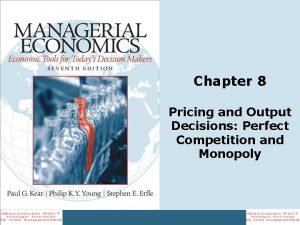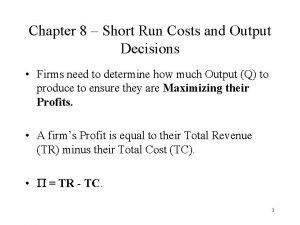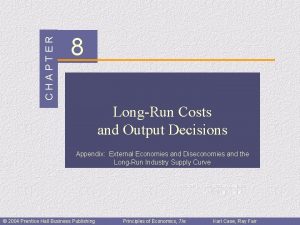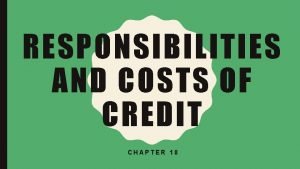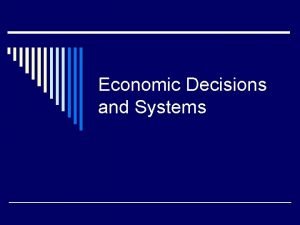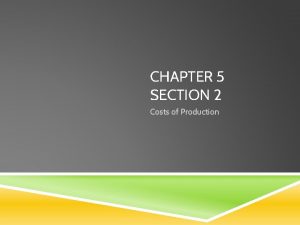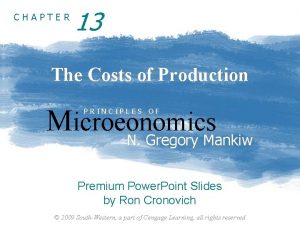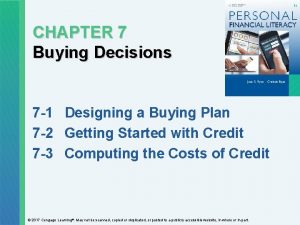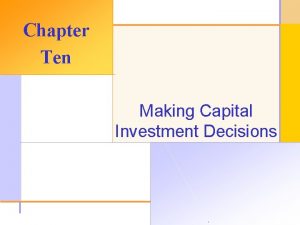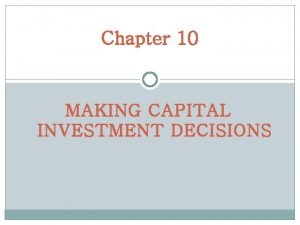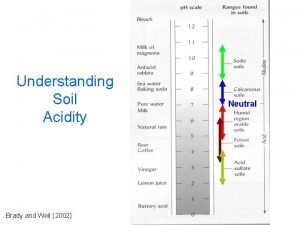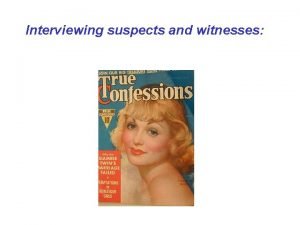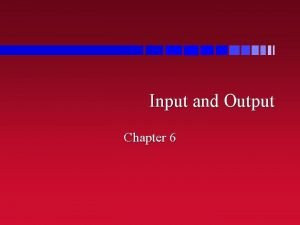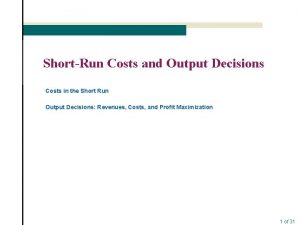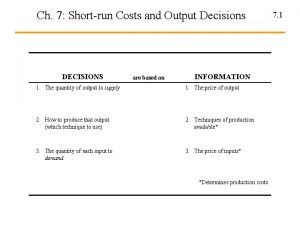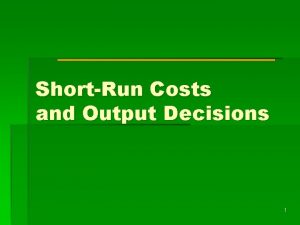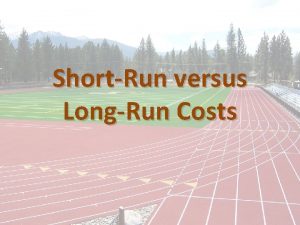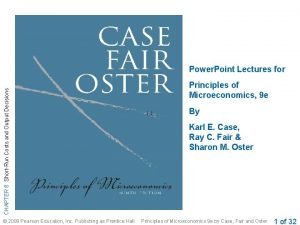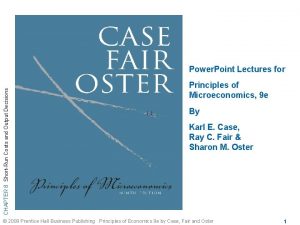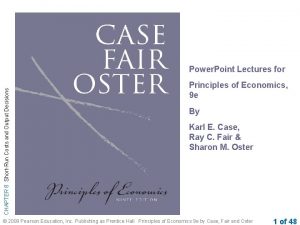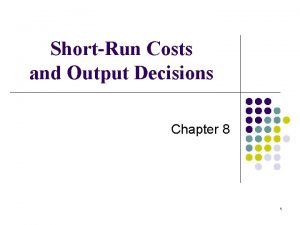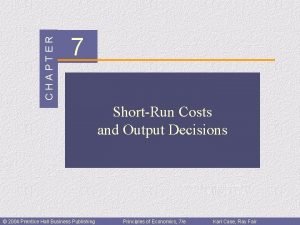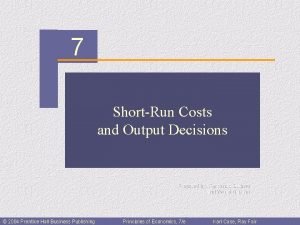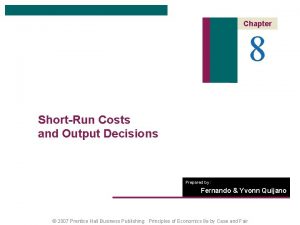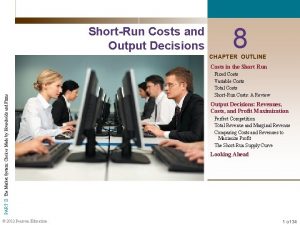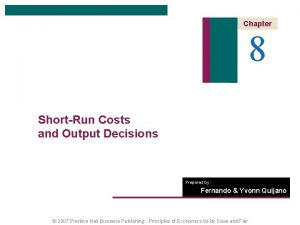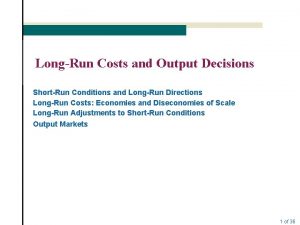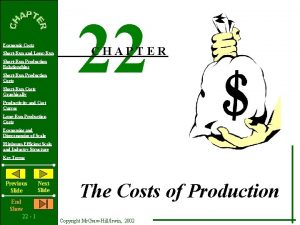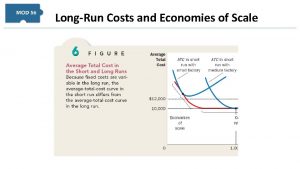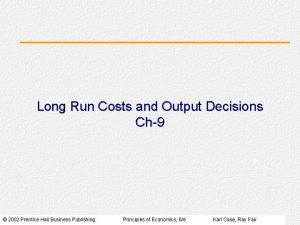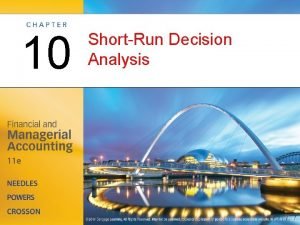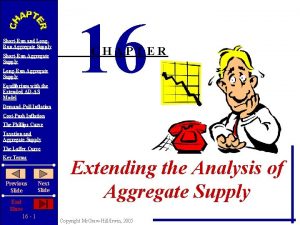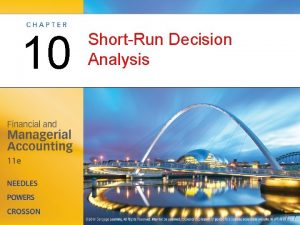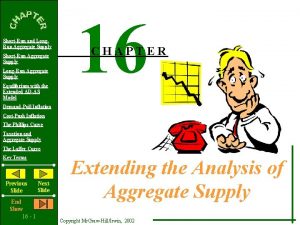ShortRun Costs and Output Decisions Chapter 8 2002
























- Slides: 24

Short-Run Costs and Output Decisions Chapter 8 © 2002 Prentice Hall Business Publishing Principles of Economics, 6/e Karl Case, Ray Fair

Decisions Facing Firms DECISIONS INFORMATION are based on 1. The quantity of output to supply 1. The price of output 2. How to produce that output (which technique to use) 2. Techniques of production available* 3. The quantity of each input to demand 3. The price of inputs* *Determines production costs © 2002 Prentice Hall Business Publishing Principles of Economics, 6/e Karl Case, Ray Fair

Costs in the Short Run • • The short run is a period of time for which two conditions hold: 1. The firm is operating under a fixed scale (fixed factor) of production, and 2. Firms can neither enter nor exit an industry. In the short run, all firms have costs that they must bear regardless of their output. These kinds of costs are called fixed costs © 2002 Prentice Hall Business Publishing Principles of Economics, 6/e Karl Case, Ray Fair

Costs in the Short Run • Fixed cost is any cost that does not depend on the firm’s level of output. These costs are incurred even if the firm is producing nothing, i. e. , output=0. • Variable cost is a cost that depends on the level of production chosen. Total Cost = Total Fixed + Total Variable Cost © 2002 Prentice Hall Business Publishing Principles of Economics, 6/e Karl Case, Ray Fair

Total Fixed Costs and Average Fixed Costs • Total fixed costs are also called overheads • Firms have no control over fixed costs in the short run. For this reason, fixed costs are sometimes called sunk costs. • Average fixed cost (AFC) is the total fixed cost (TFC) divided by the number of units of output (q): © 2002 Prentice Hall Business Publishing Principles of Economics, 6/e Karl Case, Ray Fair

Short-Run Fixed Cost (Total and Average) of a Hypothetical Firm (1) q (output) (2) TFC (3) AFC =(TFC/q) $ -- 0 $1, 000 1 1, 000 2 1, 000 500 3 1, 000 333 4 1, 000 250 5 1, 000 200 • AFC falls as output rises; a phenomenon sometimes called spreading overhead. • AFC never reaches zero © 2002 Prentice Hall Business Publishing Principles of Economics, 6/e Karl Case, Ray Fair

Variable Costs • The total variable cost curve is a graph that shows the relationship between total variable cost and the level of a firm’s output. The total variable cost depends on: 1. Technique of production and 2. input prices. © 2002 Prentice Hall Business Publishing Principles of Economics, 6/e Karl Case, Ray Fair

Derivation of Total Variable Cost Schedule from Technology and Factor Prices PRODUCT USING TECHNIQUE UNITS OF INPUT REQUIRED (PRODUCTION FUNCTION) K L TOTAL VARIABLE COST ASSUMING PK = $2, PL = $1 TVC = (K x PK) + (L x PL) 1 Units of output A B 4 2 4 6 (4 x $2) + (4 x $1) = $12 (2 x $2) + (6 x $1) = $10 2 Units of output A B 7 4 6 10 (7 x $2) + (6 x $1) = $20 (4 x $2) + (10 x $1) = $18 3 Units of output A B 9 6 6 14 (9 x $2) + (6 x $1) = $24 (6 x $2) + (14 x $1) = $26 • The total variable cost curve shows the cost of production using the best available technique at each output level, given current factor prices • Here, K denotes variable capital in the short run © 2002 Prentice Hall Business Publishing Principles of Economics, 6/e Karl Case, Ray Fair

Marginal Cost • Marginal cost (MC) is the increase in total cost that results from producing one more unit of output. • Marginal cost reflects changes in variable costs (fixed costs do not change when output changes, hence the only relevant cost here is the variable cost) © 2002 Prentice Hall Business Publishing Principles of Economics, 6/e Karl Case, Ray Fair

Derivation of Marginal Cost from Total Variable Cost UNITS OF OUTPUT TOTAL VARIABLE COSTS ($) MARGINAL COSTS ($) 0 10 2 18 8 3 24 6 • Marginal cost measures the additional cost of inputs required to produce each successive unit of output (refer to previous table) © 2002 Prentice Hall Business Publishing Principles of Economics, 6/e Karl Case, Ray Fair

The Shape of the Marginal Cost Curve in the Short Run • The fact that in the short run every firm is constrained by some fixed input means that: 1. The firm faces diminishing returns to variable inputs, and 2. The firm has limited capacity to produce output. • As a firm approaches that capacity, it becomes increasingly costly to produce successively higher levels of output. • Hence diminishing returns or decreasing marginal product imply increasing marginal cost © 2002 Prentice Hall Business Publishing Principles of Economics, 6/e Karl Case, Ray Fair

The Shape of the Marginal Cost Curve in the Short Run • Marginal costs ultimately increases with output in the short run. © 2002 Prentice Hall Business Publishing Principles of Economics, 6/e Karl Case, Ray Fair

Graphing Total Variable Costs and Marginal Costs • Total variable costs always increases with output-slope always positive. • The marginal cost curve shows how total variable cost changes with single unit increases in total output. • Below 100 units of output, TVC increases at a decreasing rate. Beyond 100 units of output, TVC increases at an increasing rate. © 2002 Prentice Hall Business Publishing Principles of Economics, 6/e Karl Case, Ray Fair

Average Variable Cost • Average variable cost (AVC) is the total variable cost divided by the number of units of output. (AVC =TVC/q) • Marginal cost is the cost of one additional unit. Average variable cost is the average variable cost per unit of all the units being produced. • Average variable cost follows marginal cost, but lags behind. © 2002 Prentice Hall Business Publishing Principles of Economics, 6/e Karl Case, Ray Fair

Relationship Between Average Variable Cost and Marginal Cost • When marginal cost is below average cost, average cost is declining. • When marginal cost is above average cost, average cost is increasing. • Rising marginal cost intersects average • At 200 units of output, AVC variable cost at the is minimum, and MC = AVC. minimum point of AVC. © 2002 Prentice Hall Business Publishing Principles of Economics, 6/e Karl Case, Ray Fair

Short-Run Costs of a Hypothetical Firm (1) q (2) TVC (3) MC (D TVC) (4) AVC (TVC/q) (5) TFC (6) TC (TVC + TFC) - $ 1, 000 (7) AFC (TFC/q) 0 $ - 1 10 10 10 1, 000 1, 010 2 18 8 9 1, 000 1, 018 500 509 3 24 6 8 1, 000 1, 024 333 341 4 32 8 8 1, 000 1, 032 250 258 5 42 10 8. 4 1, 000 1, 042 200 208. 4 0 $ $ $ - (8) ATC (TC/q or AFC + AVC) $ - - - - - - - 500 8, 000 20 16 1, 000 9, 000 © 2002 Prentice Hall Business Publishing Principles of Economics, 6/e 2 Karl Case, Ray Fair 18

Total Costs • Adding TFC to TVC means adding the same amount of total fixed cost to every level of total variable cost. • Thus, the total cost curve has the same shape as the total variable cost curve; it is simply higher by an amount equal to TFC. © 2002 Prentice Hall Business Publishing Principles of Economics, 6/e Karl Case, Ray Fair

Average Total Cost • Average total cost (ATC) is total cost divided by the number of units of output (q). • Because AFC falls with output, an ever-declining amount is added to AVC. © 2002 Prentice Hall Business Publishing Principles of Economics, 6/e Karl Case, Ray Fair

Relationship Between Average Total Cost and Marginal Cost • ATC follows the MC curve but lags behind it • If marginal cost is below average total cost, average total cost will decline toward marginal cost. • If marginal cost is above average total cost, average total cost will increase. • Marginal cost intersects average total cost and average variable cost curves at their minimum points. © 2002 Prentice Hall Business Publishing Principles of Economics, 6/e Karl Case, Ray Fair

Output Decisions: Revenues, Costs, and Profit Maximization • In the short run, a competitive firm faces a demand curve that is simply a horizontal line at the market equilibrium price. © 2002 Prentice Hall Business Publishing Principles of Economics, 6/e Karl Case, Ray Fair

Total Revenue (TR) and Marginal Revenue (MR) • Total revenue (TR) is the total amount that a firm takes in from the sale of its output. • Marginal revenue (MR) is the additional revenue that a firm takes in when it increases output by one additional unit. • In perfect competition, P = MR. © 2002 Prentice Hall Business Publishing Principles of Economics, 6/e Karl Case, Ray Fair

Comparing Costs and Revenues to Maximize Profit • The profit-maximizing level of output for all firms is the output level where MR = MC. • In perfect competition, MR = P, therefore, the profit-maximizing perfectly competitive firm will produce up to the point where the price of its output is just equal to short-run marginal cost. • The key idea here is that firms will produce as long as marginal revenue exceeds marginal cost. © 2002 Prentice Hall Business Publishing Principles of Economics, 6/e Karl Case, Ray Fair

Profit Analysis for a Simple Firm (1) q (2) TFC (3) TVC $ 0 (4) MC $ - (5) P = MR (6) TR (P x q ) $ 15 $ 0 $ 10 10 10 15 2 10 15 5 3 10 20 4 10 5 6 $ -10 15 20 -5 15 30 25 5 5 15 45 30 10 15 60 40 20 10 50 20 15 75 60 15 10 80 30 15 90 90 0 Principles of Economics, 6/e $ (8) PROFIT (TR - TC) 10 © 2002 Prentice Hall Business Publishing 0 (7) TC (TFC + TVC) Karl Case, Ray Fair

The Short-Run Supply Curve • At any market price, the marginal cost curve shows the output level that maximizes profit. Thus, the marginal cost curve of a perfectly competitive profit-maximizing firm is the firm’s short-run supply curve. © 2002 Prentice Hall Business Publishing Principles of Economics, 6/e Karl Case, Ray Fair
 Image making meaning
Image making meaning Screening decisions and preference decisions
Screening decisions and preference decisions Pricing and output decisions in perfect competition
Pricing and output decisions in perfect competition Short run cost and output decisions
Short run cost and output decisions Long run cost and output decisions
Long run cost and output decisions Chapter 18 responsibilities and costs of credit
Chapter 18 responsibilities and costs of credit Chapter 4 financial decisions and planning
Chapter 4 financial decisions and planning Chapter 4 financial decisions and planning
Chapter 4 financial decisions and planning Loan vocabulary
Loan vocabulary Chapter 1 economic decisions and systems answer key
Chapter 1 economic decisions and systems answer key Chapter 4 financial decisions and planning
Chapter 4 financial decisions and planning Chapter 4 financial decisions and planning
Chapter 4 financial decisions and planning Chapter 4 financial decisions and planning
Chapter 4 financial decisions and planning Chapter 5 section 2 costs of production
Chapter 5 section 2 costs of production Mankiw chapter 13
Mankiw chapter 13 Chapter 7 buying decisions
Chapter 7 buying decisions An organized method for making good buying decisions
An organized method for making good buying decisions Cca tax shield formula excel
Cca tax shield formula excel Chapter 10 making capital investment decisions
Chapter 10 making capital investment decisions Brady and weil 2002
Brady and weil 2002 Kouzes and posner transformational leadership model
Kouzes and posner transformational leadership model Milne and bull 2002
Milne and bull 2002 Bartholow and anderson 2002
Bartholow and anderson 2002 Chapter 6 input and output
Chapter 6 input and output Touch screen input output
Touch screen input output


